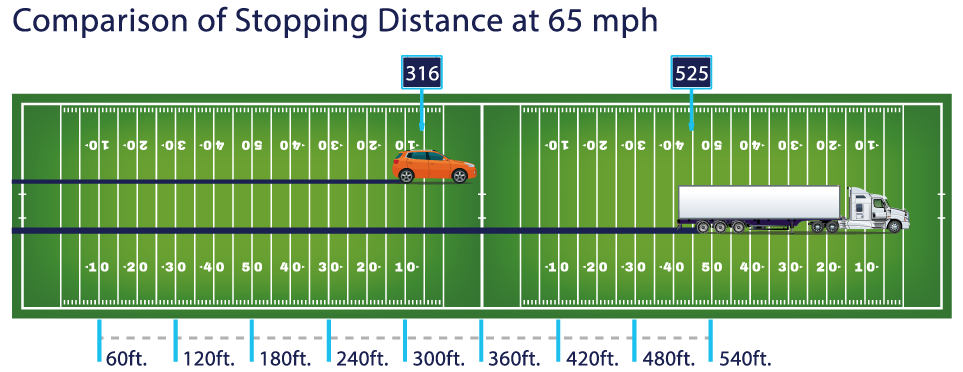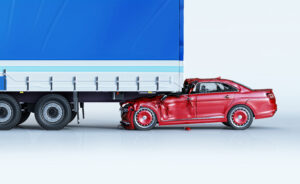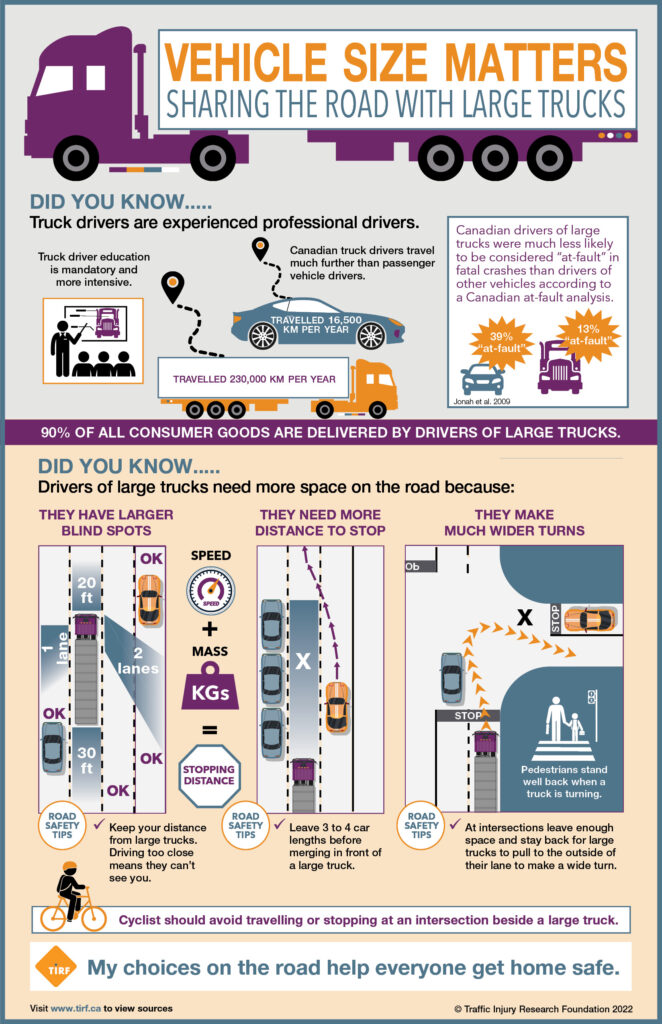Vehicle Size Matters: Staying focused when sharing the road with large trucks
By: Robyn Robertson & Karen Bowman, Traffic Injury Research Foundation
Originally published by Traffic Injury Research Foundation and cross-posted with permission.
Top safety strategies for driving around large trucks

No matter where you drive on the almost 900,000 kms of roadway in Canada (or more than 4 million kms in the US / 559,234 miles), odds are you’re sharing the road with large trucks. If you’ve been driving for more years than you care to count (like us), chances are the more memorable takeaways from driver education classes all those years ago focused on seatbelts, speeding and shoulder checks. I suspect many of you might be hard-pressed to recall any teachings about sharing the road with large trucks in a classroom.
I hadn’t really thought about some of the important differences between passenger vehicles and large trucks until my first encounter with a large truck on the road which happened pretty early on in my driving career. At age 18, I was practicing highway driving with my instructor and two other students in the instructor’s vehicle. It was a dark, snowy, windy night in February on a poorly lit highway. My driving instructor was distracted from the road, and talking to the other students about things we would be learning. He paused, mid-sentence, to tell me to make a left turn off the highway (without a dedicated left-turn lane) at the bottom of a pretty steep hill so I could pull into a rest stop to switch drivers. It seemed pretty simple…..except for the fully loaded logging truck which appeared out of nowhere, barreling down the hill behind me, headlights looming.
Now having grown up in Northern Ontario, I fortunately had the benefit of spending a lot of time as a passenger travelling on single-lane highways in the winter with lots of truck traffic. Needless to say, I just knew from experience (and physics class) it was pretty unlikely the truck driver was going to be able to slow down, much less stop quickly in these conditions. One glance in the rearview mirror and my instincts screamed KEEP GOING!!!!!!!!
I did, and fortunately, I lived to tell the tale. I’m pretty sure my instructor gave me an A right then and there. But not everyone’s first encounter with a large truck has been so fortunate, and I strongly recommend against learning about this topic in the school of hard knocks.
So, what are the top three strategies to drive safely around large trucks?

Source: UDOT Zero Fatalities – Truck Smart, udot.utah.gov
Give large trucks enough space on the road. The stopping distance a vehicle needs is directly influenced by its mass. Vehicles that are bigger and heavier need more distance to stop. It’s that simple. Think about how much bigger a tractor-trailer (a.k.a. an 18-wheeler) is compared to a typical passenger vehicle. The length of a tractor-trailer is equal to 3 or more passenger vehicles. When they are loaded with consumer goods, livestock, food, or 6 to 8 brand-new, shiny vehicles, they can weigh tens of thousands of pounds. Bringing that large, heavy vehicle to a sudden stop, particularly when travelling at highway speeds, takes a heck of a lot of distance. So, under ideal conditions, the stopping distance of a passenger vehicle travelling at 65 mph is about 300 feet whereas a fully loaded semi-truck travelling at the same speed would need at least 525 feet to come to a stop. That’s nearly 1.5 times the length of a standard American football field (360 feet / 120 yards) and more than twice the length of an NHL hockey rink (200 feet /66.7 yards). No matter your sport of choice, we can all agree, that is a long, long way for a vehicle the size and mass of a fully loaded semi-truck to come to a complete stop.
 So, when you see that truck driver with a large open space ahead of them, it’s BECAUSE THEY NEED IT. It’s their safety strategy to ensure they don’t drive over the vehicle in front of them if a random driver ahead suddenly slams on their brakes (you know who you are). It’s NOT an invitation for you to fill the gap, particularly in unpredictable stop-and-go traffic. This strategy used by truck drivers becomes particularly critical to your safety when travelling at highway speeds and when approaching traffic lights. The same is true for following distance behind a heavy truck. If the vehicle stops suddenly but you can’t, you’ll end up underneath it.
So, when you see that truck driver with a large open space ahead of them, it’s BECAUSE THEY NEED IT. It’s their safety strategy to ensure they don’t drive over the vehicle in front of them if a random driver ahead suddenly slams on their brakes (you know who you are). It’s NOT an invitation for you to fill the gap, particularly in unpredictable stop-and-go traffic. This strategy used by truck drivers becomes particularly critical to your safety when travelling at highway speeds and when approaching traffic lights. The same is true for following distance behind a heavy truck. If the vehicle stops suddenly but you can’t, you’ll end up underneath it.
 Pass a large truck instead of hanging out beside it. Tire blowouts are actually common on the highway, and one of the worst places to be when this happens is beside a large truck travelling at highway speed. If you have never experienced or witnessed a blowout on a large truck, it sounds like a sonic boom. It’s enough to startle drivers and cause them to lose control of their vehicles. It is also possible that debris from the tire may strike you, or drivers may suddenly swerve to avoid it. Tire blowouts can also result in the truck jack-knifing and blocking other lanes of traffic or rolling over. So, when you pull out to pass a large truck, make sure you have room to get ALL the way past it, and any drivers coming behind can also get safely past. In other words, this is not the time to sit back and let your cruise control take several minutes to slowly inch you ahead of the truck. Once you’re past it, wait until you can see the driver’s headlights in our rearview mirror before pulling back in.
Pass a large truck instead of hanging out beside it. Tire blowouts are actually common on the highway, and one of the worst places to be when this happens is beside a large truck travelling at highway speed. If you have never experienced or witnessed a blowout on a large truck, it sounds like a sonic boom. It’s enough to startle drivers and cause them to lose control of their vehicles. It is also possible that debris from the tire may strike you, or drivers may suddenly swerve to avoid it. Tire blowouts can also result in the truck jack-knifing and blocking other lanes of traffic or rolling over. So, when you pull out to pass a large truck, make sure you have room to get ALL the way past it, and any drivers coming behind can also get safely past. In other words, this is not the time to sit back and let your cruise control take several minutes to slowly inch you ahead of the truck. Once you’re past it, wait until you can see the driver’s headlights in our rearview mirror before pulling back in.
 Blind spots for large trucks are substantially larger than a passenger vehicle. Due to the height of the driver’s seat and the length of the vehicle, blind zones for large truck drivers are exponentially larger. This is true not only for pedestrians and cyclists but also for motorcyclists and passenger vehicle drivers. A good rule of thumb is that if you can’t see the truck driver in their side mirrors, then THEY CAN’T SEE YOU. This is such an important piece of information that many trucks have this safety messaging on the back doors of their trucks.
Blind spots for large trucks are substantially larger than a passenger vehicle. Due to the height of the driver’s seat and the length of the vehicle, blind zones for large truck drivers are exponentially larger. This is true not only for pedestrians and cyclists but also for motorcyclists and passenger vehicle drivers. A good rule of thumb is that if you can’t see the truck driver in their side mirrors, then THEY CAN’T SEE YOU. This is such an important piece of information that many trucks have this safety messaging on the back doors of their trucks.
Large trucks have become a constant presence on our roadways. More than 90% of all consumer products and perishables are shipped by truck in Canada. We rely on the trucking industry to bring the large majority of goods and services we use every day to stores in our community or directly to our door. As a result, the number of registered trucks in Canada has increased in the past decade from 1,072,000 in 2013 to 1,310,000 in 2021.
The standards and training required to obtain a commercial motor vehicle licence have also risen significantly in the past decade. Mandatory training, driver coaching, alcohol and drug testing and the use of driver monitoring systems to combat distraction and fatigue are just a few examples of the higher standards that truck drivers must meet to keep their licences. These drivers also spend more than twice as much time driving as passenger vehicle drivers, meaning they have a lot more experience. As a result, truck drivers are some of the safest drivers on our roads.
But this shouldn’t mean passenger vehicle drivers are complacent when it comes to sharing the road. It’s our job to prepare for the unexpected, and let’s face it, a lot of unexpected happens out there these days.
Learning how to safely share the roads with large trucks is something we can all do to ensure everyone gets home to their family at the end of the day. Some of the great resources available to communities, employers, and families to help raise awareness about important safety strategies for sharing the road with large trucks are included in the below infographic.
Download & share this helpful infographic on safely sharing the road with large trucks:
#MySafeRoadHome blog co-authors: Robyn Robertson, TIRF President & CEO and Karen Bowman, TIRF Director, Communications & Programs (Drop It And Drive® – DIAD), work collaboratively as co-authors, drawing from Robyn’s breadth of knowledge on topics alongside Karen’s blogging background and experience leading the DIAD program since 2010. Robyn is the author of TIRF’s knowledge translation model and is well-versed in implementation strategies and operational practices across several sectors. To date, the DIAD program has been delivered to over 60,000 youth and workplaces across North America.
Coalition Commentary is a periodic blog series exploring tips and best practices for reducing distraction and driving safely.
Source documents and resources:
Vehicle Size Matters – Sharing the Road with Large Trucks Infographic (2022), https://tirf.ca/download/sharing-road-large-trucks-infographic
Road Safety Bulletin: A Question of Size (2016), Traffic Injury Research Foundation https://tirf.ca/TIRFCAD16A
Sharing the Road with Commercial Vehicles, US National Distracted Driving Coalition, September 2023 https://usnddc.org/wp-content/uploads/2023/08/NDDC-Share-the-Road-Factsheet-9.pdf
Transport Canada, https://tc.canada.ca/en/road-transportation/statistics-data/canadian-motor-vehicle-traffic-collision-statistics-2021
Stopping Distance, Toronto Police Service https://www.tps.ca/media-centre/stories/slow-down-to-speed-up-reaction-time/ and https://www.facebook.com/TorontoPolice/photos/a.10150641089846297/10156050546491297/?type=3
Semi Trucks Can’t Stop Like Cars – Truck Smart, Utah Department of Transportation https://trucksmart.udot.utah.gov/wp-content/uploads/2016/08/Truck_Smart_Stopping_Distance_Fact_Sheet.pdf
Our Roads, Our Safety® and Tips for Truck and Bus Drivers, Federal Motor Carrier Safety Administration https://www.fmcsa.dot.gov/ourroads and https://www.fmcsa.dot.gov/ourroads/tips-truck-and-bus-drivers
How Long Does It Take a Semi-Truck to Stop?, Pride Transport | Jan 13, 2022 https://www.pridetransport.com/news-and-events/how-long-does-it-take-a-semitruck-to-stop
Related topics:
 |
 |
 |
 |
NDDC Steering Committee Press Contacts
Nick Chabarria
Automobile Club Of Missouri
JOE YOUNG
Insurance Institute for Highway Safety

